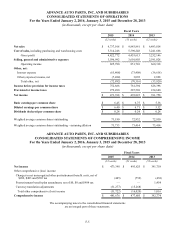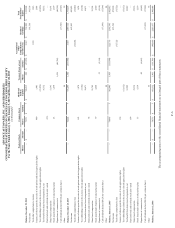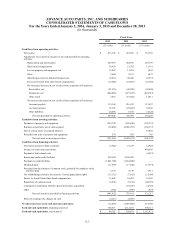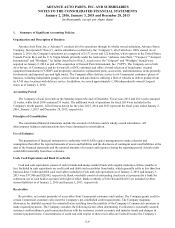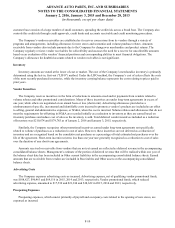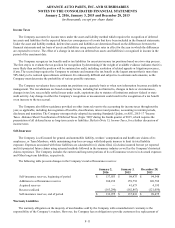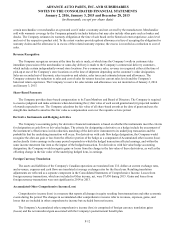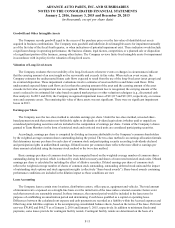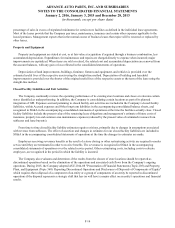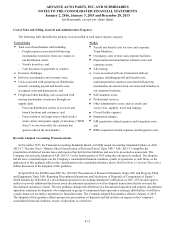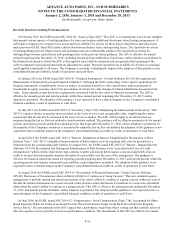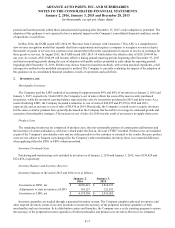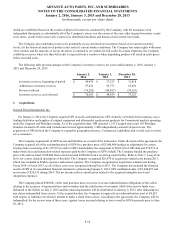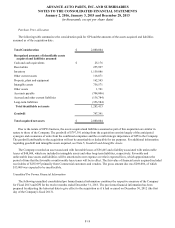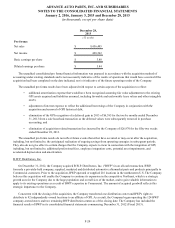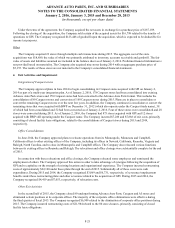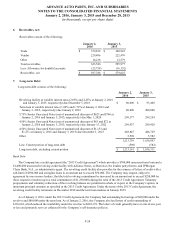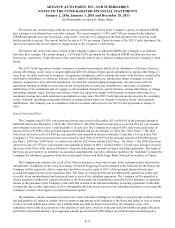Advance Auto Parts 2015 Annual Report Download - page 69
Download and view the complete annual report
Please find page 69 of the 2015 Advance Auto Parts annual report below. You can navigate through the pages in the report by either clicking on the pages listed below, or by using the keyword search tool below to find specific information within the annual report.
ADVANCE AUTO PARTS, INC. AND SUBSIDIARIES
NOTES TO THE CONSOLIDATED FINANCIAL STATEMENTS
January 2, 2016, January 3, 2015 and December 28, 2013
(in thousands, except per share data)
F-15
Cost of Sales and Selling, General and Administrative Expenses
The following table identifies the primary costs classified in each major expense category:
Cost of Sales SG&A
Total cost of merchandise sold including: Payroll and benefit costs for store and corporate
- Freight expenses associated with moving Team Members;
merchandise inventories from our vendors to Occupancy costs of store and corporate facilities;
our distribution center, Depreciation and amortization related to store and
- Vendor incentives, and corporate assets;
- Cash discounts on payments to vendors; Advertising;
Inventory shrinkage; Costs associated with our Commercial delivery
Defective merchandise and warranty costs; program, including payroll and benefit costs,
Costs associated with operating our distribution and transportation expenses associated with moving
network, including payroll and benefit costs, merchandise inventories from our stores and branches to
occupancy costs and depreciation; and our customer locations;
Freight and other handling costs associated with Self-insurance costs;
moving merchandise inventories through our Professional services;
supply chain Other administrative costs, such as credit card
- From our distribution centers to our store and service fees, supplies, travel and lodging;
branch locations and customers, and Closed facility expense;
- From certain of our larger stores which stock a Impairment charges;
wider variety and greater supply of inventory (“HUB GPI acquisition-related expenses and integration costs;
stores”) to our stores after the customer has and
special-ordered the merchandise. BWP acquisition-related expenses and integration costs.
Recently Adopted Accounting Pronouncements
In November 2015, the Financial Accounting Standards Board, or FASB, issued Accounting Standards Update, or ASU,
2015-17, "Income Taxes - Balance Sheet Classification of Deferred Taxes (Topic 740)." ASU 2015-17 simplifies the
presentation of deferred income taxes and requires that deferred tax liabilities and assets be presented as noncurrent. The
Company elected early adoption of ASU 2015-17 in the fourth quarter of 2015 using the retrospective method. The adoption
did not have a material impact on the Company's consolidated financial condition, results of operations or cash flows, as the
application of this guidance affects only classification in the consolidated balance sheets. Refer to Note 13, Income Taxes, for a
further discussion of the adoption of this guidance.
In April 2014, the FASB issued ASU No. 2014-08 "Presentation of Financial Statements (Topic 205) and Property, Plant,
and Equipment (Topic 360): Reporting Discontinued Operations and Disclosures of Disposals of Components of Equity",
which amends the definition of a discontinued operation in Accounting Standards Codification, or ASC, 205-20 and requires
entities to provide additional disclosures about discontinued operations as well as disposal transactions that do not meet the
discontinued operations criteria. The new guidance changes the definition of a discontinued operation and requires discontinued
operations treatment for disposals of a component or group of components that represents a strategic shift that has or will have
a major impact on an entity’s operations or financial results. The Company adopted this guidance effective January 4, 2015.
The adoption of this guidance affects prospective presentation of disposals and did not have an impact on the Company's
consolidated financial condition, results of operations or cash flows.


